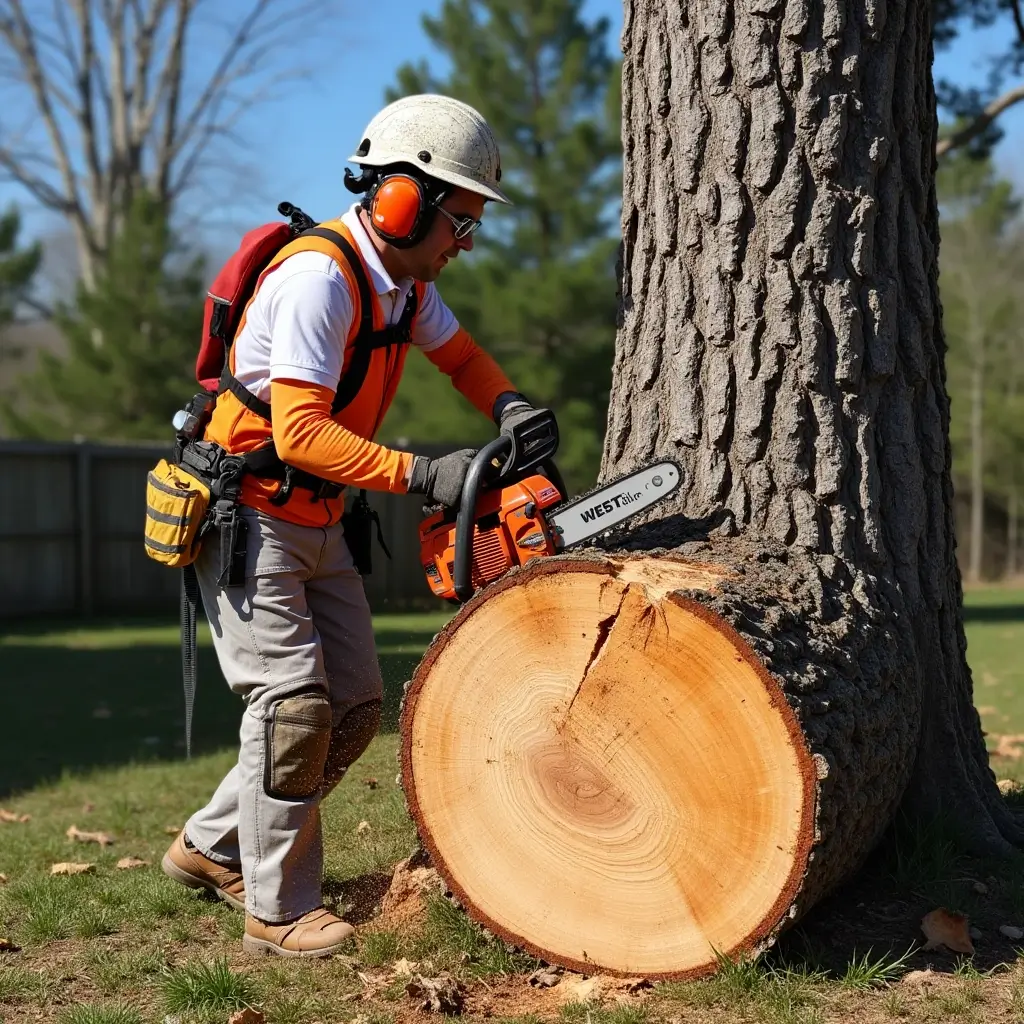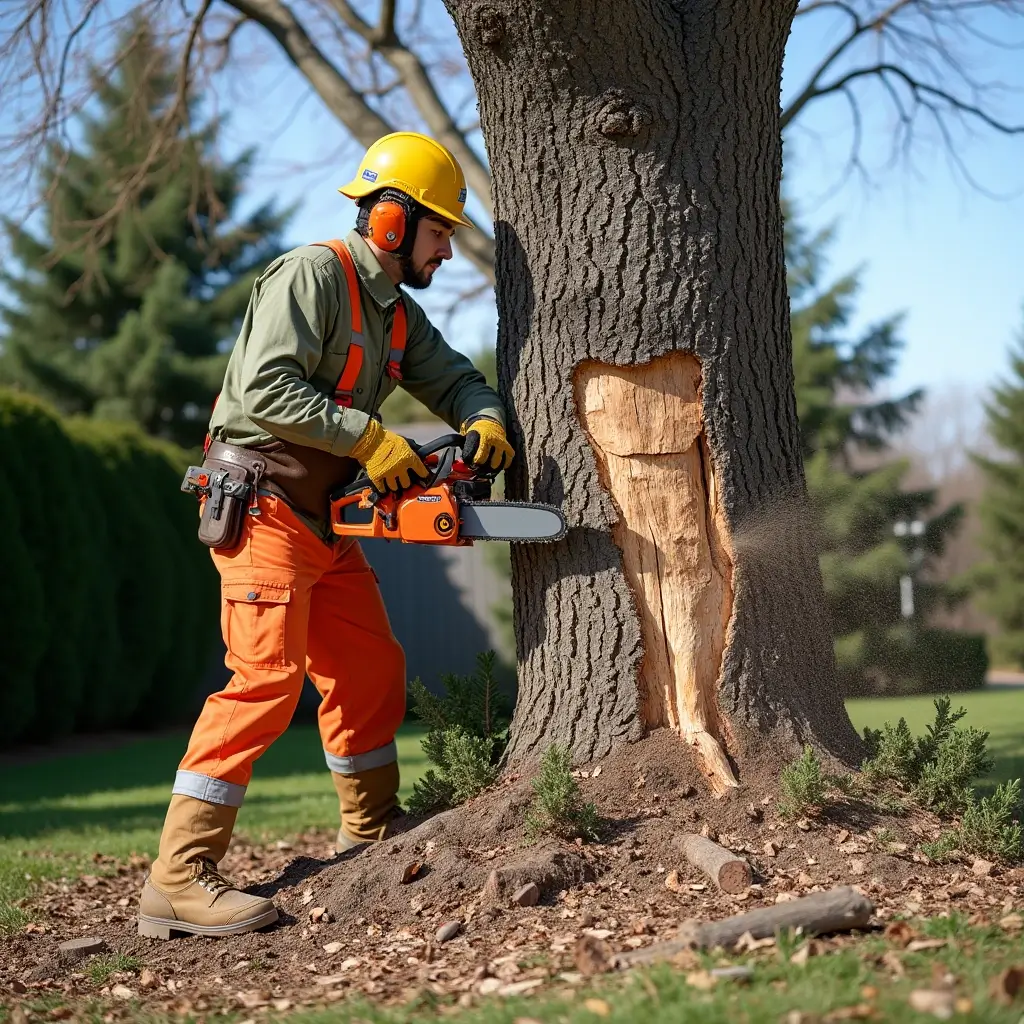Cut a tree is a big job, and one that comes with significant responsibility. Whether you’re clearing space in your yard, dealing with a tree that’s threatening your property, or simply removing a tree that has outgrown its place, it’s important to approach the task with the right tools, knowledge, and precautions.
This guide is here to show you exactly how to cut a tree safely and effectively, step by step. By the end, you’ll feel confident tackling the job, ensuring that the process is done efficiently and without unnecessary risks.
Why You Might Need to Cut a Tree
There are many reasons you might decide to cut down a tree, but the decision is not one that should be made lightly. Let’s explore some common scenarios where tree removal might be necessary.
Common Reasons for Tree Removal
- Tree Health Issues
If your tree is diseased, dead, or severely damaged, it could be posing a risk to your home and surrounding plants. Trees can harbor pests and diseases that spread quickly, and if left unchecked, they can cause more harm than good. Signs of disease include discolored leaves, dying branches, or unusual growth patterns. - Safety Concerns
Trees that are leaning towards your house, or have large, dead branches, can be a major safety hazard. High winds or storms may cause the tree to fall, potentially damaging property or even injuring someone. If you notice cracks, splits, or visible leaning in the trunk, the tree may be too dangerous to leave standing. - Space or Landscaping Needs
Sometimes, trees need to be cut down to make room for new landscaping, construction, or garden expansions. If a tree is blocking sunlight from reaching your garden or is interfering with utility lines, it may need to go. - Storm Damage
After a storm, trees can suffer significant damage, including broken branches or uprooting. If a tree’s structural integrity is compromised, it’s important to remove it as soon as possible to avoid further damage.
Legal Considerations Before Cutting a Tree
Before grabbing your chainsaw, check with your local authorities. In many places, cutting down a tree—especially one that’s large or on public property—may require a permit. Fines and penalties for illegal tree removal can be steep, so ensure that you’re in compliance with local laws before proceeding.
Also, check if the tree is near property lines. If it’s not on your land, you’ll need permission from the neighbor or property owner to proceed with the removal.

Essential Tools for Cutting a Tree
When it comes to cut a tree, having the right tools is essential for both safety and efficiency. Whether you’re taking down a large tree or trimming smaller branches, using the appropriate equipment will make the process smoother and safer. Here are the tools you’ll need to get the job done.
Basic Tree Cutting Tools
- Chainsaw
A chainsaw is the most efficient tool for cutting down a tree. If you’re working with a large tree, this is a must-have. Make sure it’s in good condition and that the chain is sharp. You can either rent or purchase a chainsaw based on the size of your project. - Axe or Hatchet
For smaller trees or trimming branches, an axe or hatchet can be helpful. These tools are especially useful for manual tasks and when cutting through smaller trunks. - Pruning Saw
A pruning saw is ideal for cutting off smaller branches or limbs before taking down the main trunk. If there are any low-hanging branches, remove them first to avoid obstruction when felling the tree. - Rope and Pulley
If the tree is in a tricky position or near other structures, ropes and pulleys can be used to control the direction of the fall. This is especially useful for larger trees where precision is key to avoid damage.
Safety Gear and Protective Equipment
- Helmet with Face Shield
Protect your head and eyes from falling debris by wearing a sturdy helmet with a face shield or goggles. This is crucial when working with chainsaws or chopping down larger trees. - Chainsaw Chaps
These protective pants are designed to prevent chainsaw accidents from injuring your legs. They’re made from durable, impact-resistant materials that can stop a chain saw if it makes contact with your legs. - Gloves and Steel-Toed Boots
Chainsaw gloves will protect your hands from cuts and abrasions, while steel-toed boots protect your feet from falling objects. Ensure the boots are slip-resistant for better stability. - Ear Protection
Chainsaws are loud machines. Prolonged exposure to high-decibel noise can cause hearing damage, so make sure you wear ear protection to safeguard your hearing.
How to Cut a Tree Safely and Effectively
Now that you have the right tools and safety gear, it’s time to dive into the step-by-step process of how to cut a tree. Follow these steps carefully to ensure that you’re working safely and efficiently.
Step 1: Assess the Tree and Its Environment
Before you even start cutting, take some time to assess the tree and its surroundings. This is a critical step that will determine how you proceed with the job.
- Check for Lean
Stand back and look at the tree. Observe the direction in which the tree is leaning. The tree’s lean will determine where it will naturally fall. If it’s leaning towards a structure or power lines, this is a red flag and may require professional assistance. - Look for Hazards
Ensure that there are no obstacles like buildings, fences, or power lines in the path of the tree’s fall. If the tree is in a difficult spot, you may need to use ropes or hire a professional to safely remove it. - Check the Tree’s Health
Look for any signs of disease or weakness. If the tree has a hollow trunk, cracks, or signs of significant decay, it might break unexpectedly when you start cutting.
Step 2: Make a Plan for Felling the Tree
Felling a tree requires strategy. A good plan ensures that the tree falls in the right direction and avoids damaging nearby structures. Here’s how to plan:
- Choose the Direction of Fall
The direction the tree will fall should be free of obstacles. It should ideally fall in a direction that minimizes the risk of injury or property damage. - Cut a Notch on the Tree
The notch is one of the most important cuts, as it will guide the tree’s fall. Stand on the side of the tree that faces the fall direction. Use your chainsaw to cut a horizontal notch (about 1/3 of the tree’s diameter) and then make a second cut at a 70-degree angle. This will create a notch resembling a “V.” - Plan an Escape Route
Always have an escape route in mind. Stand on the opposite side of where the tree is falling, and make sure to walk away at a 45-degree angle to the falling tree.
Step 3: Cutting the Tree – The Techniques
Now, the time has come to cut a tree. Follow these steps carefully to ensure a smooth felling process:
1. Making the Notch Cut
- Start by making a horizontal cut at chest height on the side of the tree facing the fall direction. This cut should be about 1/3 of the way through the tree’s trunk.
- Then, make a second cut from above the first, creating a notch that angles downward. This notch will help the tree to fall in the right direction.
2. The Felling Cut
- The felling cut should be made on the opposite side of the notch, slightly above the horizontal cut.
- Make the felling cut slightly off-center (toward the notch side) to create a “hinge.” The hinge will control the direction the tree falls and prevent it from veering off course.
3. Watch for the Tree’s Movement
As you cut, the tree will begin to lean and start to fall. Be prepared to move quickly. As soon as you see the tree start to tilt, retreat along your planned escape route.
Step 4: Handling the Tree’s Fall and Removing the Stump
Once the tree is on the ground, the work is far from over.
- Clearing the Area: Make sure no one is near the tree when it falls. You should be at least 20 feet away from the fall area.
- Cutting the Stump: The stump can be removed using a chainsaw or stump grinder. If the stump is large, you may need to hire a professional to grind it down to below ground level.

Important Safety Tips for Cutting a Tree
While cutting a tree can be a rewarding and manageable task, safety should always be your top priority. Here are some essential safety tips:
Personal Safety Precautions
- Work with a Partner: Tree cutting is not a one-person job, especially with larger trees. Having a second person on hand can help with the process and provide assistance in case of an emergency.
- Check Your Equipment: Before starting, ensure that all tools are in good working condition, including your chainsaw, safety gear, and protective equipment.
- Take Breaks: Tree cutting can be physically demanding. Take regular breaks to avoid exhaustion and stay sharp.
Environmental and Surrounding Area Safety
- Be Aware of Power Lines: Never cut a tree near power lines unless you have received special training and have the proper tools.
- Keep Your Distance: Always keep bystanders, pets, and children well away from the work area.
- Inspect the Weather: Avoid cutting trees during high winds or storms, as this increases the risk of injury and accidents.
Common Mistakes to Avoid When Cutting a Tree
Even experienced tree cutters can make mistakes. Avoid these common errors to ensure a safe and successful project:
- Not Assessing the Tree’s Lean: Failing to assess the tree’s lean can result in an unpredictable fall, causing damage or injury.
- Improper Notch Cuts: If the notch isn’t made properly, the tree may not fall in the desired direction.
- Ignoring Safety Gear: Never underestimate the importance of safety gear. Even small accidents can result in serious injuries.
The Importance of Tree Cutting Knowledge
Cutting a tree may seem like a daunting task at first, but with the right preparation, tools, and knowledge, it’s entirely doable. Whether you’re doing it for safety reasons, landscaping, or other needs, understanding how to cut a tree safely and effectively will ensure the job is done right.
Remember, if the task to cut a tree feels too complex or dangerous, there’s no harm in calling in a professional. Arborists have the expertise to assess and remove trees safely, ensuring that you avoid unnecessary risks.
Ready to take on your tree cutting project? Make sure you’ve got the right tools, know your safety precautions, and have a solid plan in place. Happy tree cutting!
If you’re not sure where to start, or if you’re looking for professional tree removal services, get in touch with a certified arborist near you. Stay safe, and make your yard a safer, more beautiful place!
FAQ: Answers to Common Tree Cutting Questions
What is the proper way to cut a tree?
The proper way to cut a tree involves a series of careful steps to ensure safety and precision:
- Assess the Tree and Its Environment: Check the tree’s health, the direction it leans, and the surroundings. Look for any hazards like power lines, structures, or other trees.
- Wear Safety Gear: Before starting, make sure you’re wearing protective equipment, including a helmet, gloves, safety glasses, chainsaw chaps, and steel-toed boots.
- Make the Notch Cut: On the side of the tree facing the direction you want it to fall, make a horizontal cut about one-third of the way through the tree’s trunk. Then, make a second cut at a 70-degree angle above the horizontal cut to form a notch. This will guide the tree’s fall.
- Make the Felling Cut: On the opposite side of the notch, slightly above the horizontal cut, make the felling cut. This cut should be horizontal, and it will create a “hinge” that helps control the tree’s fall direction.
- Retreat to Safety: Once the tree starts to lean, quickly move along your escape route, which should be at a 45-degree angle to the direction of the fall.
- Cut the Stump: After the tree has fallen, you can remove the stump using a chainsaw or stump grinder.
What is the cutting method of trees?
There are several cutting methods used for tree removal, but the most common are:
- Felling with a Chainsaw: The standard method for cutting down a tree involves making a notch cut and then a felling cut. The notch guides the tree’s fall, while the felling cut controls the tree’s descent.
- Directional Felling: This is the process of ensuring that the tree falls in a predetermined direction. It involves creating a notch on the side of the tree facing the desired fall direction and then cutting on the opposite side to create a “hinge” that guides the fall.
- Notch and Back Cut: This method involves creating a notch at a 70-degree angle on the side of the tree facing the fall direction, followed by a horizontal back cut slightly above the notch to allow the tree to fall in the planned direction.
How to cut a tree so it falls where you want?
To cut a tree so that it falls where you want, follow these steps:
- Assess the Lean: Stand back and look at the tree to determine the natural lean. The tree will likely fall in the direction it leans, so this is important in deciding where to cut.
- Create a Notch: On the side of the tree that faces the desired fall direction, make a horizontal cut (about one-third of the tree’s diameter) and then a second angled cut above the first. This notch should be at a 70-degree angle and should be clean and precise to direct the fall.
- Make the Felling Cut: On the opposite side of the notch, slightly above the horizontal cut, make a horizontal felling cut. This cut should be slightly to the side of the notch so that a “hinge” is created. The hinge controls the tree’s fall and prevents it from veering off course.
- Monitor the Fall: As you cut, watch the tree closely. Once it starts to lean, move quickly to your designated escape route and stay at a safe distance. The tree should fall in the direction of the notch you created.
How do you take cuttings from a tree?
Taking cuttings from a tree (for propagation) is different from how you cut a tree for removal. Here’s how to take successful cuttings:
- Select the Right Time: The best time to take tree cuttings is during the spring or early summer when the tree is actively growing. For woody trees, semi-hardwood cuttings work best.
- Choose Healthy Branches: Look for healthy, non-diseased branches. Choose a branch that is about 4-6 inches long with several leaves and no flowers or fruit.
- Make the Cut: Use sharp, clean pruning shears to make the cut just below a leaf node (the point where a leaf attaches to the stem). Remove any leaves or buds from the lower part of the cutting, leaving only the top few leaves.
- Prepare the Cutting for Rooting: If desired, dip the cut end of the branch in rooting hormone to encourage root growth. This step is optional but can be helpful for certain species.
- Plant the Cutting: Place the cutting in a pot with well-draining soil or a rooting medium. Keep it in a warm, humid environment and ensure it gets indirect sunlight. Mist the cutting regularly and ensure the soil stays moist but not soggy.
- Wait for Roots to Develop: It can take several weeks for the cutting to develop roots. Once roots are visible, you can transplant the cutting into a larger pot or directly into the ground.


